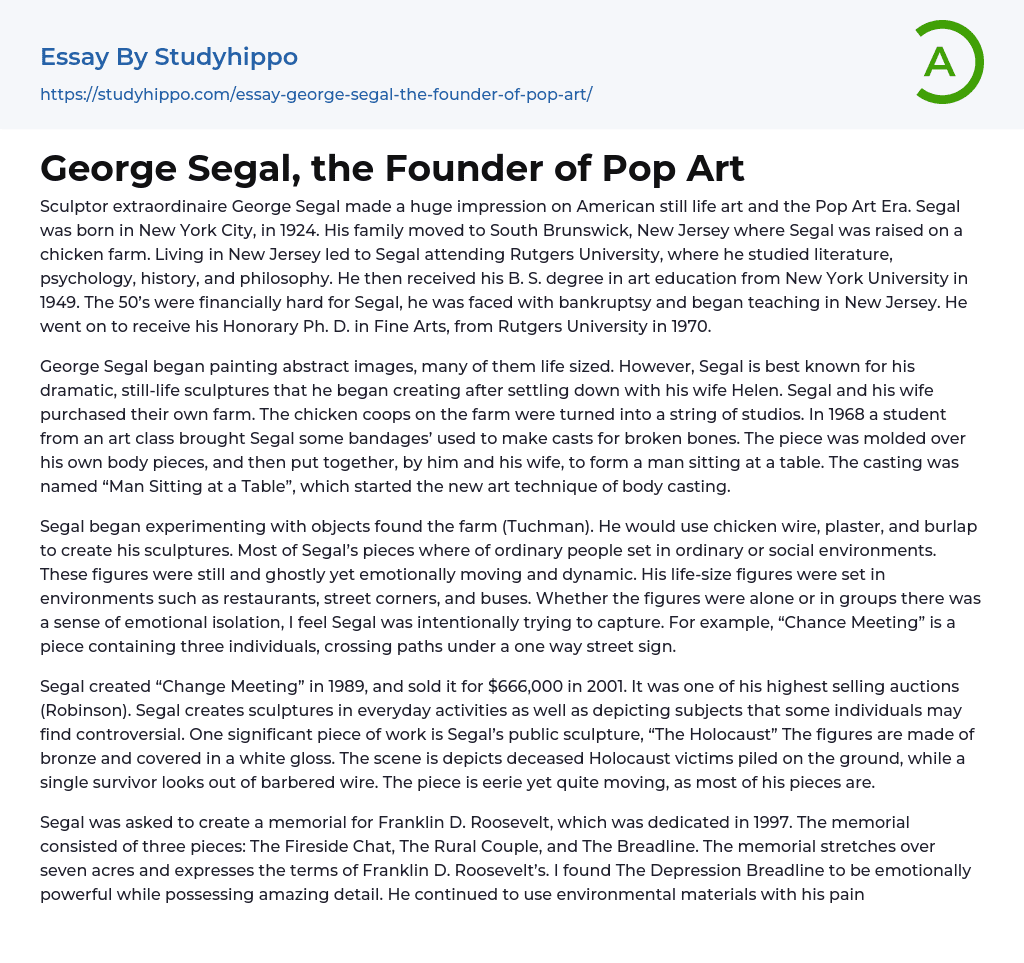Sculptor extraordinaire George Segal made a huge impression on American still life art and the Pop Art Era. Segal was born in New York City, in 1924. His family moved to South Brunswick, New Jersey where Segal was raised on a chicken farm. Living in New Jersey led to Segal attending Rutgers University, where he studied literature, psychology, history, and philosophy. He then received his B. S. degree in art education from New York University in 1949. The 50’s were financially hard for Segal, he was faced with bankruptsy and began teaching in New Jersey. He went on to receive his Honorary Ph. D. in Fine Arts, from Rutgers University in 1970.
George Segal began painting abstract images, many of them life sized. However, Segal is best known for his dramatic, still-life sculptures that he began creatin
...g after settling down with his wife Helen. Segal and his wife purchased their own farm. The chicken coops on the farm were turned into a string of studios. In 1968 a student from an art class brought Segal some bandages’ used to make casts for broken bones. The piece was molded over his own body pieces, and then put together, by him and his wife, to form a man sitting at a table. The casting was named “Man Sitting at a Table”, which started the new art technique of body casting.
Segal began experimenting with objects found the farm (Tuchman). He would use chicken wire, plaster, and burlap to create his sculptures. Most of Segal’s pieces where of ordinary people set in ordinary or social environments. These figures were still and ghostly yet emotionally moving and dynamic. His life-size figure
were set in environments such as restaurants, street corners, and buses. Whether the figures were alone or in groups there was a sense of emotional isolation, I feel Segal was intentionally trying to capture. For example, “Chance Meeting” is a piece containing three individuals, crossing paths under a one way street sign.
Segal created “Change Meeting” in 1989, and sold it for $666,000 in 2001. It was one of his highest selling auctions (Robinson). Segal creates sculptures in everyday activities as well as depicting subjects that some individuals may find controversial. One significant piece of work is Segal’s public sculpture, “The Holocaust” The figures are made of bronze and covered in a white gloss. The scene is depicts deceased Holocaust victims piled on the ground, while a single survivor looks out of barbered wire. The piece is eerie yet quite moving, as most of his pieces are.
Segal was asked to create a memorial for Franklin D. Roosevelt, which was dedicated in 1997. The memorial consisted of three pieces: The Fireside Chat, The Rural Couple, and The Breadline. The memorial stretches over seven acres and expresses the terms of Franklin D. Roosevelt’s. I found The Depression Breadline to be emotionally powerful while possessing amazing detail. He continued to use environmental materials with his paintings, as he did with his original sculptures. He would use charcoal on house paint. He also used stucco to emphasis texture.
Segal stayed active in the art world till his death. He died of cancer on June 9, 2000, in his home in New Jersey. I find Segal’s work to be astounding. His well rounded education and his amazing sense of creativity will motivate
any artist, or individual for that matter, to succeed. George Segal’s work can be found in museums around the world. Some museums currently displaying his collections are The Museum of Modern Art in New York, The Art Institute of Chicago, and the San Francisco Museum of Modern Art. Although the Pop Art Era is long gone I, and many others appreciate the originality and power found in his pieces today.
Work Cited
- http://www.smithsonianmag.com/arts-culture/art-abstract.html




